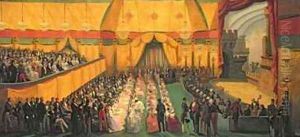Nicolas Dauzats, A. Gosse Paintings
Nicolas-Marie-Joseph Chapuy, commonly known as Nicolas Dauzats, was a French artist born on April 18, 1789, in Paris. He was a prolific painter, lithographer, and illustrator, particularly known for his architectural views and landscapes. His work is characterized by a keen interest in the accurate representation of buildings and monuments, making him a part of the Romantic movement that emphasized detailed and dramatic portrayal of historical and exotic subjects.
Dauzats initially trained under the architect Charles Percier, which greatly influenced his later work. This architectural grounding is evident in the precision of his depictions of buildings. He later shifted towards painting and became a student of the painter Antoine-Jean Gros, who was a proponent of the Romantic style in France. Dauzats' painting career was marked by his attention to detail and his skill in capturing the essence of the subjects he chose, often imbuing them with a sense of grandeur and emotion that was typical of the Romantic aesthetic.
Throughout his career, Dauzats traveled extensively, which greatly influenced his work. He visited Spain in 1823, which led to the production of a series of lithographs titled 'Voyage pittoresque en Espagne'. He also journeyed to the Middle East, visiting places such as Lebanon and Egypt. His travels provided him with a wealth of subject matter that was considered exotic to the European audience of the time. His depictions of these locations were not just topographical but also captured the atmosphere and the culture of the places he visited.
One of his significant works includes the decoration of the Château de Dampierre's chapel under the direction of the Duc de Luynes. Dauzats' work was widely appreciated during his lifetime, and he exhibited at the Paris Salon, receiving a second-class medal in 1824 and a first-class medal in 1831.
Dauzats' contribution to the field of lithography was also noteworthy. He was part of the early 19th-century French artists who embraced the medium of lithography, which was then a relatively new printmaking process. His architectural and travel lithographs were highly sought after and contributed to the popularization of lithographic art in France.
Nicolas Dauzats died on November 6, 1838, in Paris. His works remain a valuable record of architectural and cultural history of the early 19th century and reflect the Romantic interest in the grand and the picturesque. His legacy continues to be appreciated by art historians and collectors, and his pieces are held in various museum collections around the world.
